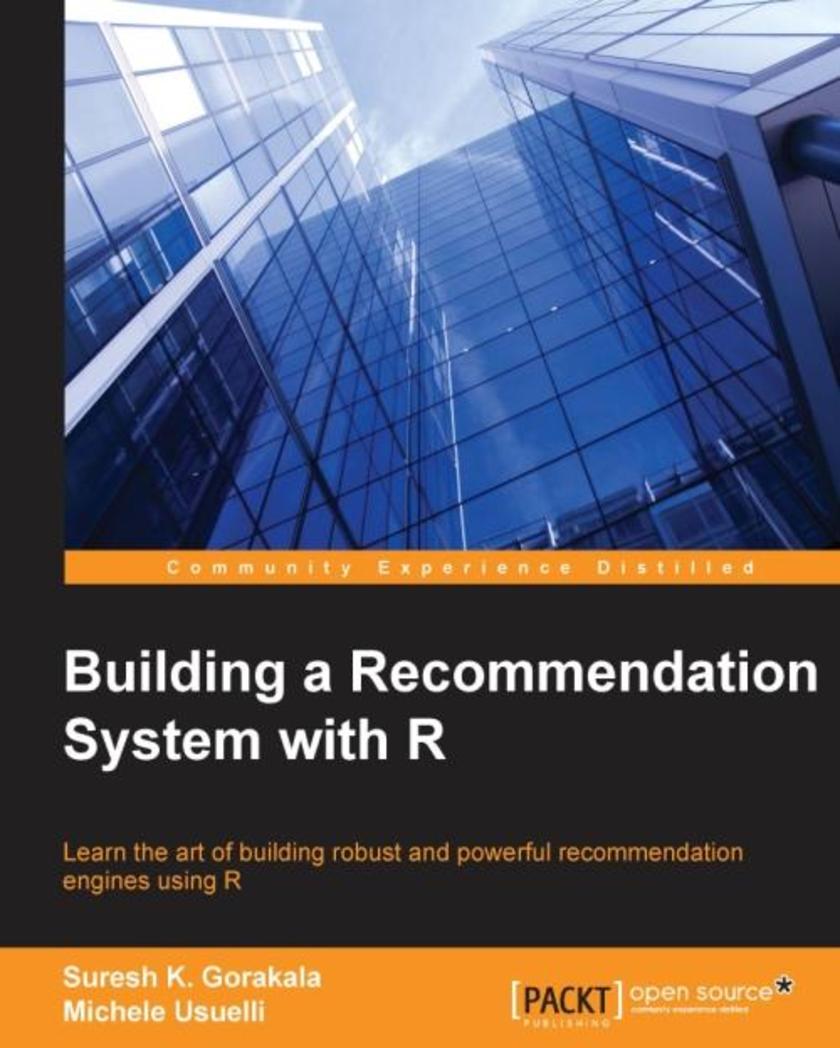
Building a Recommendation System with R
¥54.49
Learn the art of building robust and powerful recommendation engines using R About This Book Learn to exploit various data mining techniques Understand some of the most popular recommendation techniques This is a step-by-step guide full of real-world examples to help you build and optimize recommendation engines Who This Book Is For If you are a competent developer with some knowledge of machine learning and R, and want to further enhance your skills to build recommendation systems, then this book is for you. What You Will Learn Get to grips with the most important branches of recommendation Understand various data processing and data mining techniques Evaluate and optimize the recommendation algorithms Prepare and structure the data before building models Discover different recommender systems along with their implementation in R Explore various evaluation techniques used in recommender systems Get to know about recommenderlab, an R package, and understand how to optimize it to build efficient recommendation systems In Detail A recommendation system performs extensive data analysis in order to generate suggestions to its users about what might interest them. R has recently become one of the most popular programming languages for the data analysis. Its structure allows you to interactively explore the data and its modules contain the most cutting-edge techniques thanks to its wide international community. This distinctive feature of the R language makes it a preferred choice for developers who are looking to build recommendation systems. The book will help you understand how to build recommender systems using R. It starts off by explaining the basics of data mining and machine learning. Next, you will be familiarized with how to build and optimize recommender models using R. Following that, you will be given an overview of the most popular recommendation techniques. Finally, you will learn to implement all the concepts you have learned throughout the book to build a recommender system. Style and approach This is a step-by-step guide that will take you through a series of core tasks. Every task is explained in detail with the help of practical examples.
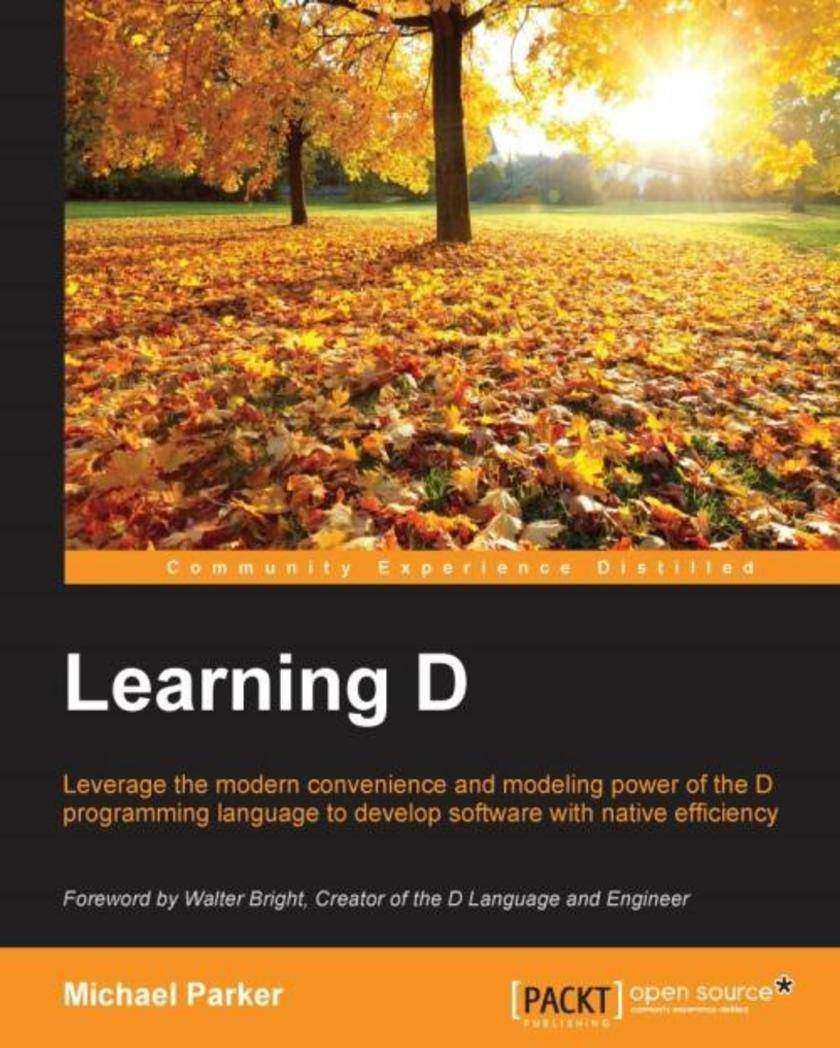
Learning D
¥90.46
Leverage the modern convenience and modelling power of the D programming language to develop software with native efficiency About This Book Acquire the skills to understand the fundamentals of D through its support for imperative and object-oriented programming Take advantage of D’s powerful compile-time features, templates and ranges to apply generative, generic, and functional style A systematic guide that will help you become familiar with the concepts in D with the help of simple and easy-to-understand examples Who This Book Is For This book is intended for those with some background in a C-family language who want to learn how to apply their knowledge and experience to D. Perhaps you’re a college student looking to use D for hobby projects, or a career programmer interested in expanding your skillset. This book will help you get up to speed with the language and avoid common pitfalls that arise when translating C-family experience to D. What You Will Learn Compile programs with DMD and manage projects with DUB Work efficiently by binding your D programs with new and existing C libraries Generate code at compile-time to enhance runtime performance Implement complex templates for more powerful generic code Write idiomatic D with range-based functional pipelines Use the DUB repository to find a link with a variety of D libraries Implement a web-app in D from the ground up In Detail D is a modern programming language that is both powerful and efficient. It combines multiple paradigms in a way that opens up a whole new world of software design. It is used to develop both desktop and web applications, with future targets including mobile, and is available on multiple platforms. It is familiar to anyone with some experience in one or more of the C-family languages. However, hidden in the similarities are several differences that can be surprising when trying to apply common idioms from other languages. When learning D on your own, this can make it more time-consuming to master. In order to make the most of the language and become an idiomatic D programmer, it’s necessary to learn how to think in D. This book familiarizes you with D from the ground up, with a heavy focus on helping you to avoid surprises so that you can take your D knowledge to the next level more quickly and painlessly. Your journey begins with a taste of the language and the basics of compiling D programs with DMD, the reference D compiler developed by Digital Mars, and DUB, a community-developed build utility and package manager. You then set out on an exploration of major language features. This begins with the fundamentals of D, including built-in types, conditionals, loops and all of the basic building-blocks of a D program, followed by an examination of D’s object-oriented programming support. You’ll learn how these features differ from languages you may already be familiar with. Next up are D’s compile-time features, such as Compile-Time Function Evaluation and conditional compilation, then generic programming with templates. After that, you’ll learn the more advanced features of ranges and functional pipeline programming. To enhance your D experience, you are next taken on a tour of the D ecosystem and learn how to make D interact with C. Finally, you get a look at D web development using the vibe.d project and the book closes with some handy advice on where to go next. Style and approach A friendly guide to the D programming language and its ecosystem that walks programmers through all they need to know for a painless experience in learning D.
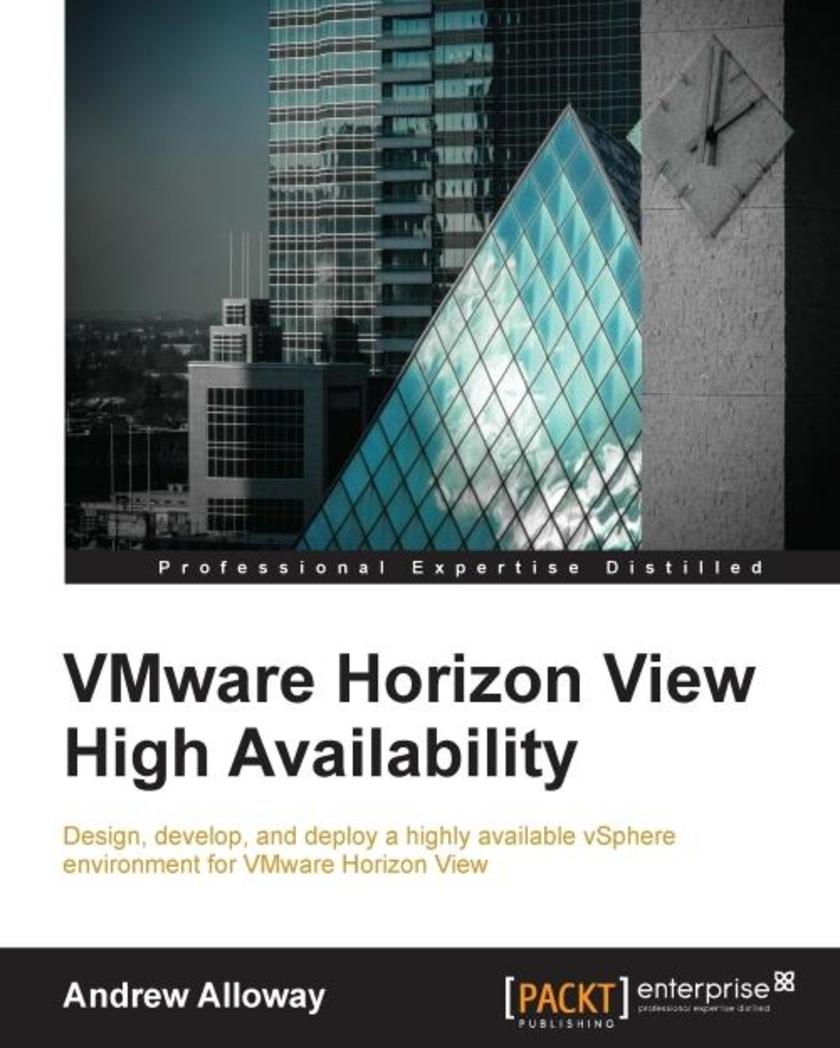
VMware Horizon View High Availability
¥80.65
Design, develop and deploy a highly available vSphere environment for VMware Horizon View About This Book Enhance your capability of meeting various Service Level Agreements in VMware Horizon View Get acquainted through all the necessary considerations for building a View environment Cover VMware High Availability hurdle by hurdle along with the checklists for verification of the environment being ready for production Who This Book Is For If you manage, plan or deploy VMware Horizon View or are looking for tips for best practices and configuration details this book is for you. This book is intended for administrators who design and deploy VMware Horizon View or administrators who are looking for ways to improve their existing View environment. What You Will Learn Install and configure a VMware Horizon View Connection Server and redundant pair Discover the networking requirements for View and learn how to build redundancy into your network Analyze each of the View user pool types and how each one can be made highly available and survivable. Get to know about storage protocols such as NFS, iSCSI and Fibre Channel Deploy Virtual SAN, and find out how to effectively couple Virtual SAN with View Learn about View monitoring tools to allow fast responses to various crises Plan, analyze and upgrade VMware Horizon View Analyze network services required for VMware Horizon View and build them in a redundant manner In Detail The increasing movement to virtualize workloads and workstations has put VMware Horizon View into a central mission critical role in many environments. Administrators may be overwhelmed with planning for outages and dealing with failure scenarios. It’s easy to miss small details that will result in outages down the road. Following VMware Horizon View best practices and planning ahead with network infrastructure will allow you to avoid these common pit falls. This book will walk you through the setup and configuration of View in a highly available configuration. It will provide you with the skills to analyze and deploy configurations that can stand up to rigorous failure standards. The book starts with deploying and basic configuration of VMware Horizon View in a redundant setup, then moves on to cover high availability for networking, fibre channel, NFS, and iSCSI. We finish this book with monitoring and upgrade planning. At the end we also learn about maintaining the uptime and minimizing the downtime that can be caused due to various factors. Each topic comes with a list of best practices and failure scenarios to test. Administrators will learn the intricacies of protecting a View environment. Style and approach This book provides configuration and installation steps for administration and installation of a Horizon View server. It includes high-level overviews of any protocols, services used by Horizon View, and best practices and high availability checklists for each chapter.
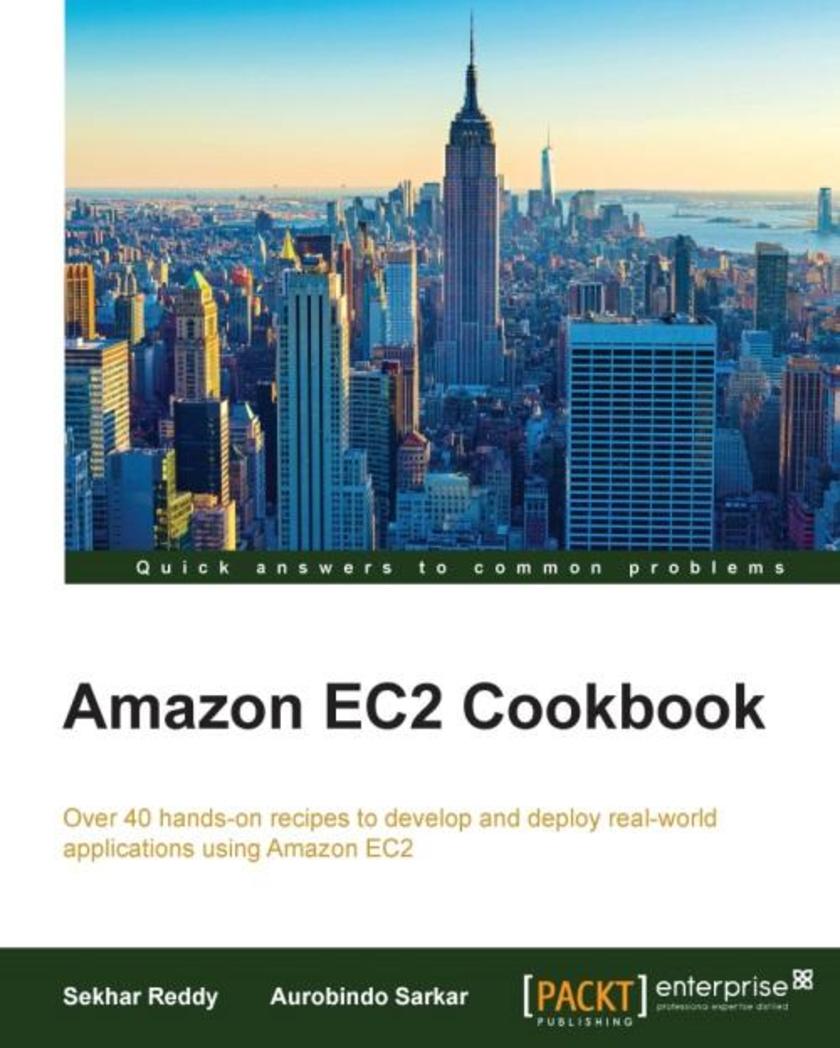
Amazon EC2 Cookbook
¥63.21
Over 40 hands-on recipes to develop and deploy real-world applications using Amazon EC2 About This Book Design and build applications using Amazon EC2 and a range of supporting AWS tools Find highly effective solutions to your AWS Cloud-based application development, deployment, and infrastructural issues A comprehensive set of recipes to implement your product’s functional and non-functional requirements Who This Book Is For This book is targeted at Cloud-based developers who have prior exposure to AWS concepts and features. Some experience in building small applications and creating some proof-of-concept applications is required. What You Will Learn Select and configure the right EC2 instances Create, configure, and secure a Virtual Private Cloud Create an AWS CloudFormation template Use AWS Identity and Access Management to secure access to EC2 instances Configure auto-scaling groups using CloudWatch Choose and use the right data service such as SimpleDB and DynamoDB for your cloud applications Access key AWS services using client tools and AWS SDKs Deploy AWS applications using Docker containers In Detail Amazon Elastic Compute Cloud (Amazon EC2) is a web service that provides flexible and resizable compute capacity in the cloud. The main purpose of Amazon EC2 is to make web-scale cloud computing easier for the developers. It offers developers and companies the raw building blocks like load balancers, object stores and virtual machines running on general hardware (that is, Amazon runs a multitude of hardware components but presents them as a generic utility to its users) with accessible APIs in order to create scalable software products This book covers designing, developing, and deploying scalable, highly available, and secure applications on the AWS platform. By following the steps in the recipes, you will be able to effectively and systematically resolve issues related to development, deployment, and infrastructure for enterprise-grade cloud applications or products. This book starts with helping you choose and configure the right EC2 instances to meet your application-specific requirements. The book then moves on to creating a CloudFormation template and will teach you how to work with stacks. You will then be introduced to using IAM services to configure users, groups, roles, and multi-factor authentication. You will also learn how to connect AD to AWS IAM. Next, you will be using AWS data services and accessing other AWS services including Route 53, Amazon S3, and AWS SES (Amazon Simple Email Service). Finally, you will be deploying AWS applications using Docker containers. Style and approach This book contains a rich set of recipes that cover not only the full spectrum of real-world cloud application development using Amazon EC2, but also the services and security of the applications. The book contains easy-to-follow recipes with step-by-step instructions to leverage EC2 within your applications.
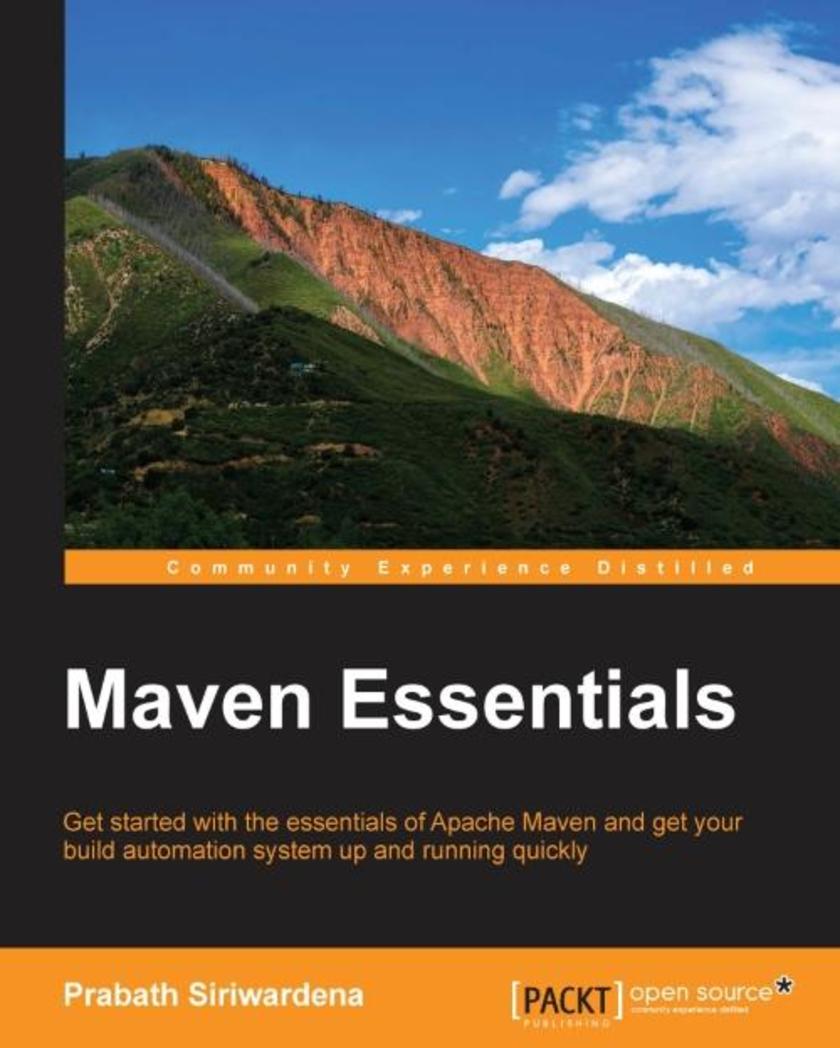
Maven Essentials
¥45.77
Get started with the essentials of Apache Maven and get your build automation system up and running quickly About This Book Explore the essentials of Apache Maven essentials to arm yourself with all the ingredients needed to develop a comprehensive build automation system Identify the extension points in Apache Maven and learn more about them in-depth Improve developer productivity by optimizing the build process with best practices in Maven using this compact guide Who This Book Is For The book is ideal for for experienced developers who are already familiar with build automation, but want to learn how to use Maven and apply its concepts to the most difficult scenarios in build automation. What You Will Learn Comprehend the key concepts in Apache Maven Build your own custom plugins and get to know how Maven extension points are used Troubleshoot build issues with greater confidence Optimize Maven’s configuration settings Write custom lifecycles and extensions Get hands-on and create a Maven assembly Explore the best practices to design a build system that improves developer productivity In Detail Maven is the #1 build tool used by developers and it has been around for more than a decade. Maven stands out among other build tools due to its extremely extensible architecture, which is built on of the concept of convention over configuration. It’s widely used by many open source Java projects under Apache Software Foundation, Sourceforge, Google Code, and more. Maven Essentials is a fast-paced guide to show you the key concepts in Maven and build automation. We get started by introducing you to Maven and exploring its core concepts and architecture. Next, you will learn about and write a Project Object Model (POM) while creating your own Maven project. You will also find out how to create custom archetypes and plugins to establish the most common goals in build automation. After this, you’ll get to know how to design the build to prevent any maintenance nightmares, with proper dependency management. We then explore Maven build lifecycles and Maven assemblies. Finally, you will discover how to apply the best practices when designing a build system to improve developer productivity. Style and approach This book is a practical and compact guide that will show you how to use Apache Maven in an optimal way to address enterprise build requirements. It provides technical guidance to get you started with Maven and build automation.
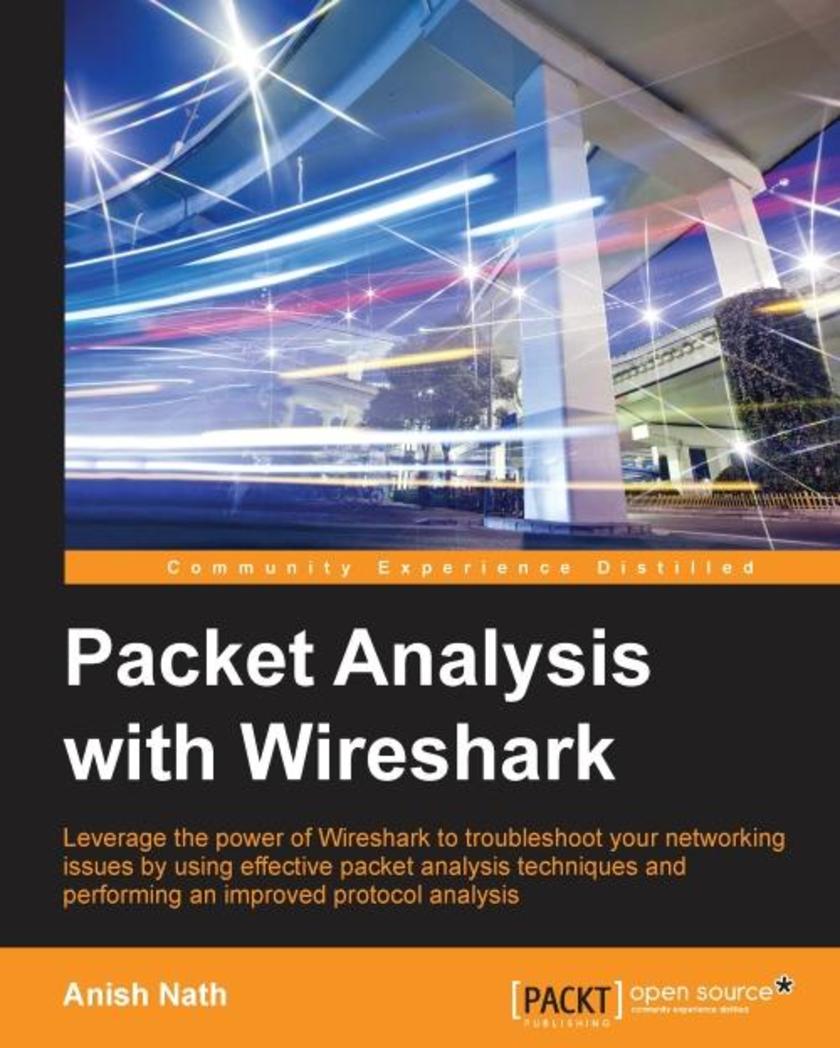
Packet Analysis with Wireshark
¥63.21
Leverage the power of Wireshark to troubleshoot your networking issues by using effective packet analysis techniques and performing improved protocol analysis About This Book Gain hands-on experience of troubleshooting errors in TCP/IP and SSL protocols through practical use cases Identify and overcome security flaws in your network to get a deeper insight into security analysis This is a fast-paced book that focuses on quick and effective packet captures through practical examples and exercises Who This Book Is For If you are a network or system administrator who wants to effectively capture packets, a security consultant who wants to audit packet flows, or a white hat hacker who wants to view sensitive information and remediate it, this book is for you. This book requires decoding skills and a basic understanding of networking. What You Will Learn Utilize Wireshark's advanced features to analyze packet captures Locate the vulnerabilities in an application server Get to know more about protocols such as DHCPv6, DHCP, DNS, SNMP, and HTTP with Wireshark Capture network packets with tcpdump and snoop with examples Find out about security aspects such as OS-level ARP scanning Set up 802.11 WLAN captures and discover more about the WAN protocol Enhance your troubleshooting skills by understanding practical TCP/IP handshake and state diagrams In Detail Wireshark provides a very useful way to decode an RFC and examine it. The packet captures displayed in Wireshark give you an insight into the security and flaws of different protocols, which will help you perform the security research and protocol debugging. The book starts by introducing you to various packet analyzers and helping you find out which one best suits your needs. You will learn how to use the command line and the Wireshark GUI to capture packets by employing filters. Moving on, you will acquire knowledge about TCP/IP communication and its use cases. You will then get an understanding of the SSL/TLS flow with Wireshark and tackle the associated problems with it. Next, you will perform analysis on application-related protocols. We follow this with some best practices to analyze wireless traffic. By the end of the book, you will have developed the skills needed for you to identify packets for malicious attacks, intrusions, and other malware attacks. Style and approach This is an easy-to-follow guide packed with illustrations and equipped with lab exercises to help you reproduce scenarios using a sample program and command lines.
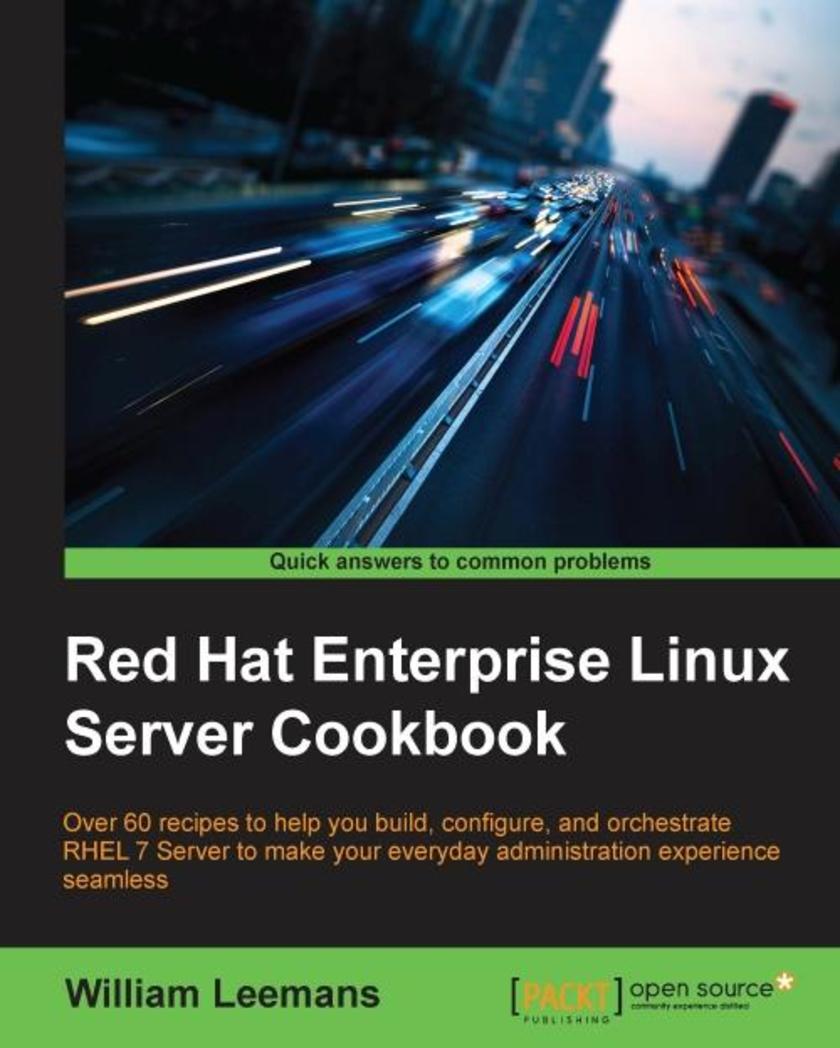
Red Hat Enterprise Linux Server Cookbook
¥90.46
Over 60 recipes to help you build, configure, and orchestrate RHEL 7 Server to make your everyday administration experience seamless About This Book Create fully unattended installations and deploy configurations without breaking a sweat Discover and kick-start the newest RHEL 7 configuration and management tools through an easy-to-follow, practical approach for a lazy system management Be guided by an experienced RHEL expert who is a certified Linux engineer with a passion for open source and open standards Who This Book Is For Red Hat Enterprise Linux Server Cookbook is for RHEL 7 system administrators and DevOps in need of a practical reference guide to troubleshoot common issues and quickly perform tasks. What You Will Learn Set up and configure RHEL 7 Server Use NetworkManager to configure all aspects of your network Manage virtual environments using libvirt Set up software repositories Secure and monitor your RHEL environment Configure SELinux, and create and apply its policies Create kickstart *s to automatically deploy RHEL 7 systems Use Orchestration and configuration management tools to manage your environment In Detail Dominating the server market, the Red Hat Enterprise Linux operating system gives you the support you need to modernize your infrastructure and boost your organization’s efficiency. Combining both stability and flexibility, RHEL helps you meet the challenges of today and adapt to the demands of tomorrow. This practical Cookbook guide will help you get to grips with RHEL 7 Server and automating its installation. Designed to provide targeted assistance through hands-on recipe guidance, it will introduce you to everything you need to know about KVM guests and deploying multiple standardized RHEL systems effortlessly. Get practical reference advice that will make complex networks setups look like child’s play, and dive into in-depth coverage of configuring a RHEL system. Also including full recipe coverage of how to set up, configuring, and troubleshoot SELinux, you’ll also discover how secure your operating system, as well as how to monitor it. Style and approach This practical guide is packed full of hands-on recipes that provide quick solutions to the problems faced when building your RHEL 7 system from scratch using orchestration tools. Each topic is explained sequentially in the process of setting up a system and binding everything together.
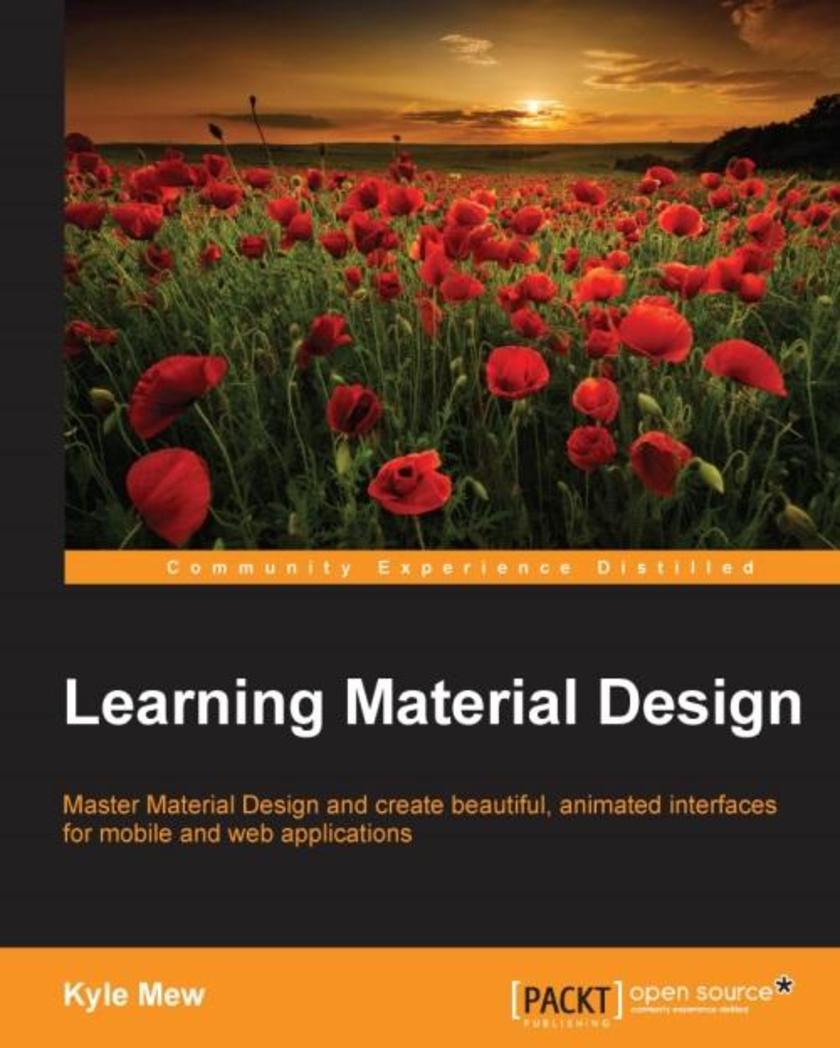
Learning Material Design
¥63.21
Master Material Design and create beautiful, animated interfaces for mobile and web applications About This Book Master the highly acclaimed Material Design paradigm and give your apps and pages the look that everyone is talking about Get a mix of key theoretical concepts combined with enough practical examples to put each theory into practice so you can create elegant material interfaces with Android Studio and Polymer Written by Kyle Mew, successful author with over a decade of mobile and web development experience, this book has both the touch of a developer as well as an experienced writer Who This Book Is For This book is ideal for web developers and designers who are interested in implementing Material Design in their mobile and web apps. No prior knowledge or experience of Material Design is required, but some familiarity with procedural languages such as Java and markup languages such as HTML will provide an advantage. What You Will Learn Implement Material Design on both mobile and web platforms that work on older handsets and browsers Design stylish layouts with the Material Theme Create and manage cards, lists, and grids Design and implement sliding drawers for seamless navigation Coordinate components to work together Animate widgets and create transitions and animation program flow Use Polymer to bring Material Design to your web pages In Detail Google's Material Design language has taken the web development and design worlds by storm. Now available on many more platforms than Android, Material Design uses color, light, and movements to not only generate beautiful interfaces, but to provide intuitive navigation for the user. Learning Material Design will teach you the fundamental theories of Material Design using code samples to put these theories into practice. Focusing primarily on Android Studio, you’ll create mobile interfaces using the most widely used and powerful material components, such as sliding drawers and floating action buttons. Each section will introduce the relevant Java classes and APIs required to implement these components. With the rules regarding structure, layout, iconography, and typography covered, we then move into animation and transition, possibly Material Design's most powerful concept, allowing complex hierarchies to be displayed simply and stylishly. With all the basic technologies and concepts mastered, the book concludes by showing you how these skills can be applied to other platforms, in particular web apps, using the powerful Polymer library. Style and approach Learning Material Design combines the theories behind material design with practical examples of how these can be implemented and further reinforcing the guidelines covering style, layout and structure.
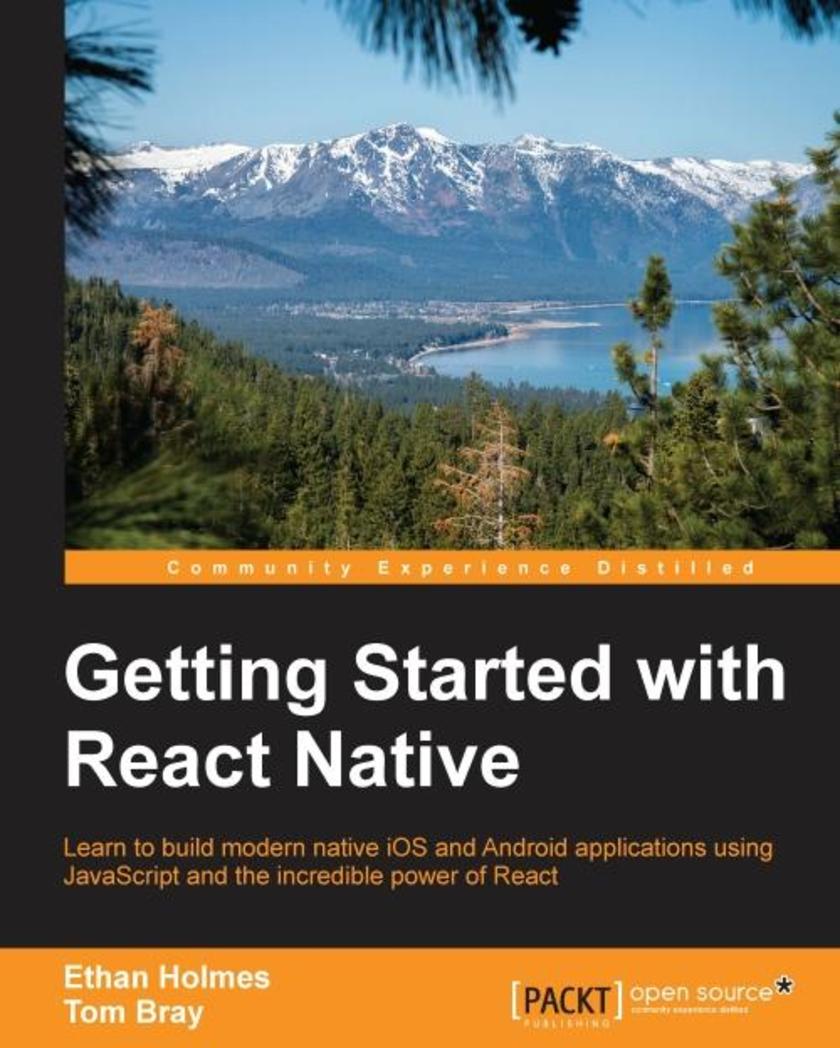
Getting Started with React Native
¥54.49
Learn to build modern native iOS and Android applications using JavaScript and the incredible power of React About This Book Learn to design and build a fully-featured application using the newest cutting-edge framework from Facebook Leverage your JavaScript skills to become a native app developer Develop custom UI components, implement smooth navigation, and access native features such as geolocation and local storage Who This Book Is For This book is for web developers who want to learn to build fast, good-looking, native mobile applications using the skills they already have. If you already have some JavaScript knowledge or are using React on the web, then you will be able to quickly get up and running with React Native for iOS and Android. What You Will Learn Set up the React Native environment on both devices and emulators Gain an in-depth understanding of how React Native works behind the scenes Write your own custom native UI components Learn the ins and outs of screen navigation Master the art of layout and styles Work with device-exclusive data such as geolocation Develop native modules in Objective-C and Java that interact with JavaScript Test and deploy your application for a production-ready environment In Detail React Native is a game-changing approach to hybrid mobile development. Web developers can leverage their existing skills to write mobile applications in JavaScript that are truly native without using cross-compilation or web views. These applications have all of the advantages of those written in Objective-C or Java, combined with the rapid development cycle that JavaScript developers are accustomed to. Web developers who want to develop native mobile applications face a high barrier to entry, because they are forced to learn platform-specific languages and frameworks. Numerous hybrid technologies have tried to simplify this process, but have failed to achieve the performance and appearance that users expect. This book will show you all the advantages of true native development that React Native has without the steep learning curve, leveraging the knowledge you already have. We do this by getting you up and running quickly with a sample application. Next, we’ll introduce you to the fundamentals of creating components and explain how React Native works under the hood. Once you have established a solid foundation, you will dive headfirst into developing a real-world application from start to finish. Along the way, we will demonstrate how to create multiple screens and navigate between them,use layout and style native UI components, and access native APIs such as local storage and geolocation. Finally, we tackle the advanced topic of Native modules, which demonstrates that there are truly no limits to what you can do with React Native. Style and approach This book provides a simple and easy way to build mobile applications in JavaScript. Each topic takes you through the life cycle of creating a fully-functional native app, with detailed explanations of the entire process.
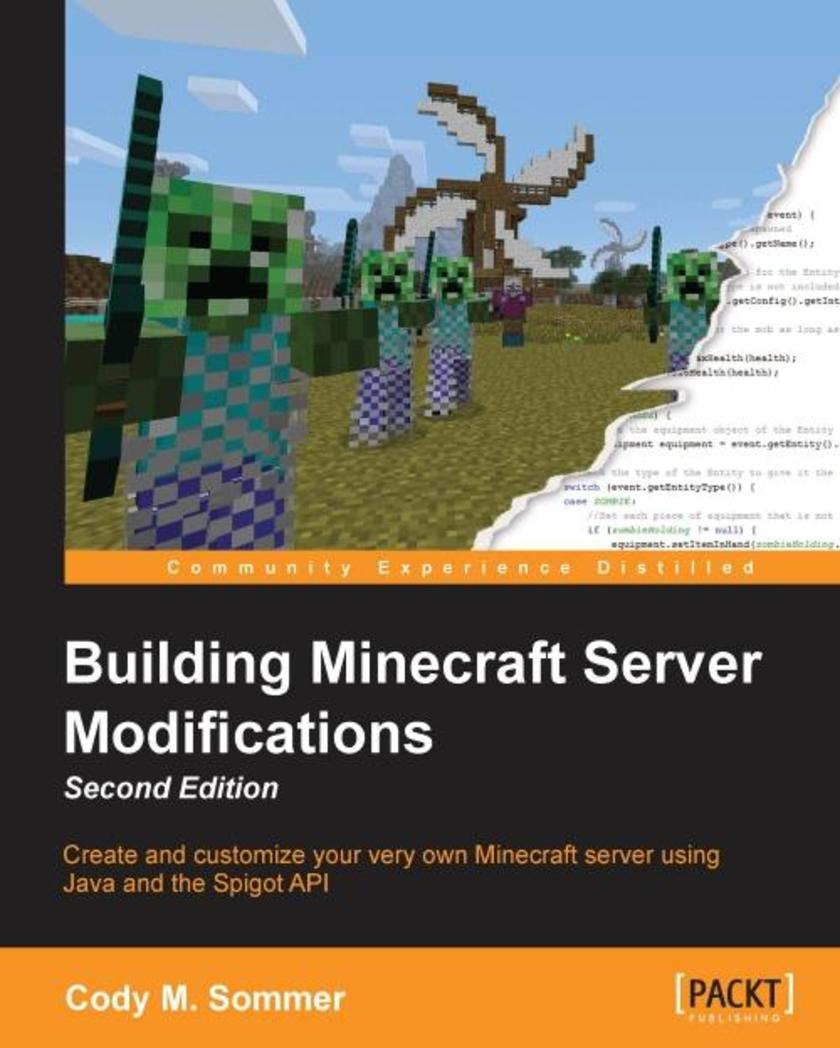
Building Minecraft Server Modifications - Second Edition
¥54.49
Create and customize your very own Minecraft server using Java and the Spigot API About This Book Set up a Minecraft server that you control Use object-oriented programming to modify Minecraft regardless of your level of experience This interactive guide will help you create a unique experience for you and your friends Who This Book Is For This book is great for anyone who is interested in customizing their Minecraft server. Whether you are new to programming, Java, Bukkit, or even Minecraft itself, this book has you covered. All you need is a valid Minecraft account. If you are interested in programming as a career or hobby, this book will get you started. If you are simply interested in playing Minecraft with your friends, then this book will help you make that experience even more enjoyable. What You Will Learn Install and run a Spigot server for free on your home PC Adjust the server settings to customize Minecraft to your liking Install an IDE and configure a project to write code Install and test plugins on a Spigot server Test your plugins through debugging the code Program in game commands and permissions Get to know advanced programming concepts such as event-driven programming, configuration files, saving/loading data, and scheduled tasks Implement configuration files to make your plugins customizable Save and load your plugin's data to persist across server restarts In Detail Minecraft is a sandbox game that allows you to play it in any way you want. Coupled with a multiplayer server powered by Spigot, you can customize the game even more! Using the Bukkit API, anyone interested in learning how to program can control their Minecraft world by developing server plugins. This book is a great introduction to software development through the wonderful world of Minecraft. We start by instructing you through how to set up your home PC for Minecraft server development. This includes an IDE complete with the required libraries as well as a Spigot server to test on. You will be guided through writing code for several different plugins. Each chapter teaches you new skills to create plugins of increasing complexity, and each plugin adds a new concept of the Bukkit API By the end of the book, you will have all the knowledge you need about the API to successfully create any type of plugin. You can then practice and build your Java skills through developing more mods for their server. Style and approach This hands-on guide is filled with interactive examples to help you modify Minecraft. Programming terms and concepts are explained along the way so even those who have never written code before can keep up.
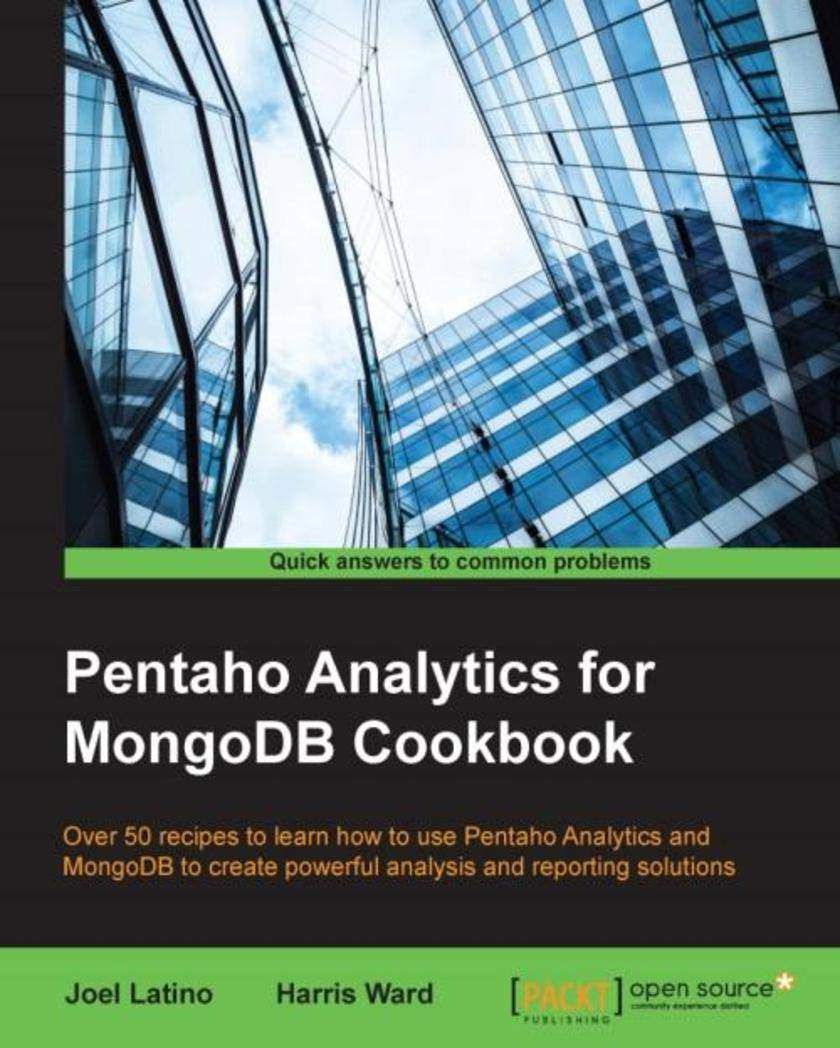
Pentaho Analytics for MongoDB Cookbook
¥80.65
Over 50 recipes to learn how to use Pentaho Analytics and MongoDB to create powerful analysis and reporting solutions About This Book Create reports and stunning dashboards with MongoDB data Accelerate data access and maximize productivity with unique features of Pentaho for MongoDB A step-by-step recipe-based guide for making full use of Pentaho suite tools with MongoDB Who This Book Is For This book is intended for data architects and developers with a basic level of knowledge of MongoDB. Familiarity with Pentaho is not expected. What You Will Learn Extract, load, and transform data from MongoDB collections to other datasources Design Pentaho Reports using different types of connections for MongoDB Create a OLAP mondrian schema for MongoDB Explore your MongoDB data using Pentaho Analyzer Utilize the drag and drop web interface to create dashboards Use Kettle Thin JDBC with MongoDB for analysis Integrate advanced dashboards with MondoDB using different types of connections Publish and run a report on Pentaho BI server using a web interface In Detail MongoDB is an open source, schemaless NoSQL database system. Pentaho as a famous open source Analysis tool provides high performance, high availability, and easy scalability for large sets of data. The variant features in Pentaho for MongoDB are designed to empower organizations to be more agile and scalable and also enables applications to have better flexibility, faster performance, and lower costs. Whether you are brand new to online learning or a seasoned expert, this book will provide you with the skills you need to create turnkey analytic solutions that deliver insight and drive value for your organization. The book will begin by taking you through Pentaho Data Integration and how it works with MongoDB. You will then be taken through the Kettle Thin JDBC Driver for enabling a Java application to interact with a database. This will be followed by exploration of a MongoDB collection using Pentaho Instant view and creating reports with MongoDB as a datasource using Pentaho Report Designer. The book will then teach you how to explore and visualize your data in Pentaho BI Server using Pentaho Analyzer. You will then learn how to create advanced dashboards with your data. The book concludes by highlighting contributions of the Pentaho Community. Style and approach A comprehensive, recipe-based guide to take complete advantage of the Pentaho Analytics for MongoDB.
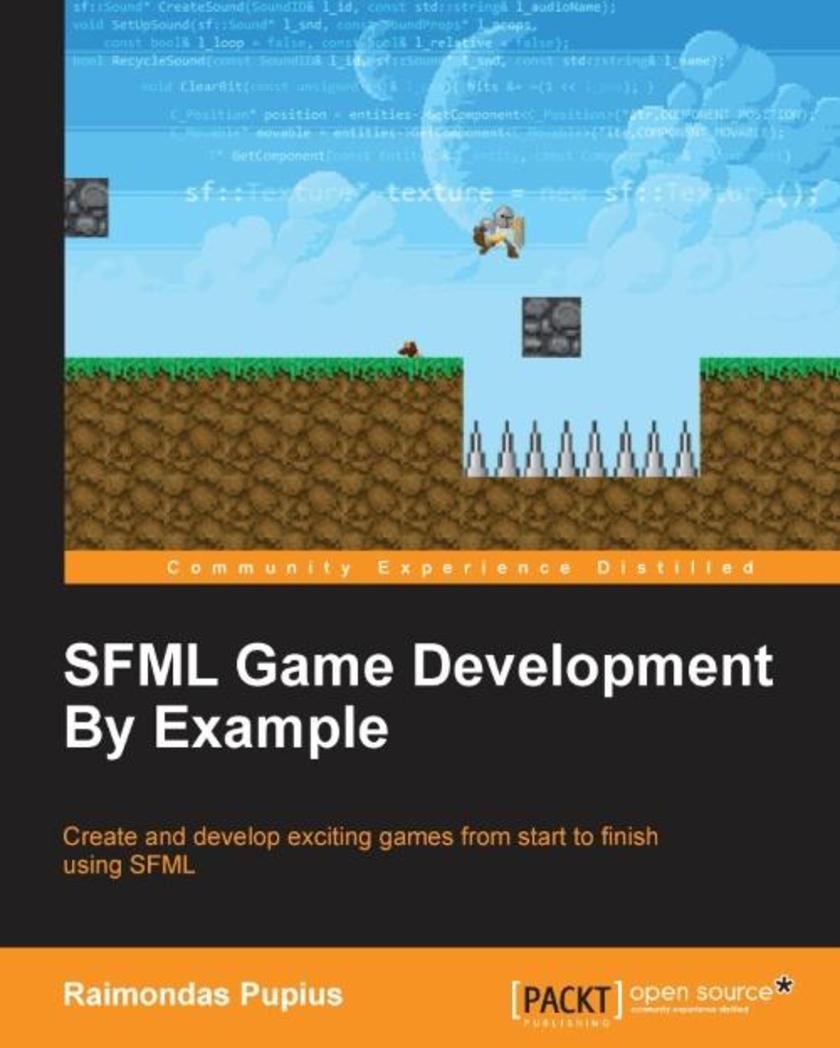
SFML Game Development By Example
¥90.46
Create and develop exciting games from start to finish using SFML About This Book Familiarize yourself with the SFML library and explore additional game development techniques Craft, shape, and improve your games with SFML and common game design elements A practical guide that will teach you how to use utilize the SFML library to build your own, fully functional applications Who This Book Is For This book is intended for game development enthusiasts with at least decent knowledge of the C++ programming language and an optional background in game design. What You Will Learn Create and open a window by using SFML Utilize, manage, and apply all of the features and properties of the SFML library Employ some basic game development techniques to make your game tick Build your own code base to make your game more robust and flexible Apply common game development and programming patterns to solve design problems Handle your visual and auditory resources properly Construct a robust system for user input and interfacing Develop and provide networking capabilities to your game< In Detail Simple and Fast Multimedia Library (SFML) is a simple interface comprising five modules, namely, the audio, graphics, network, system, and window modules, which help to develop cross-platform media applications. By utilizing the SFML library, you are provided with the ability to craft games quickly and easily, without going through an extensive learning curve. This effectively serves as a confidence booster, as well as a way to delve into the game development process itself, before having to worry about more advanced topics such as “rendering pipelines” or “shaders.” With just an investment of moderate C++ knowledge, this book will guide you all the way through the journey of game development. The book starts by building a clone of the classical snake game where you will learn how to open a window and render a basic sprite, write well-structured code to implement the design of the game, and use the AABB bounding box collision concept. The next game is a simple platformer with enemies, obstacles and a few different stages. Here, we will be creating states that will provide custom application flow and explore the most common yet often overlooked design patterns used in game development. Last but not the least, we will create a small RPG game where we will be using common game design patterns, multiple GUI. elements, advanced graphical features, and sounds and music features. We will also be implementing networking features that will allow other players to join and play together. By the end of the book, you will be an expert in using the SFML library to its full potential. Style and approach An elaborate take on the game development process in a way that compliments the reader’s existing knowledge, this book provides plenty of examples and is kind to the uninitiated. Each chapter builds upon the knowledge gained from the previous one and offers clarifications on common issues while still remaining within the scope of its own subject and retaining clarity.
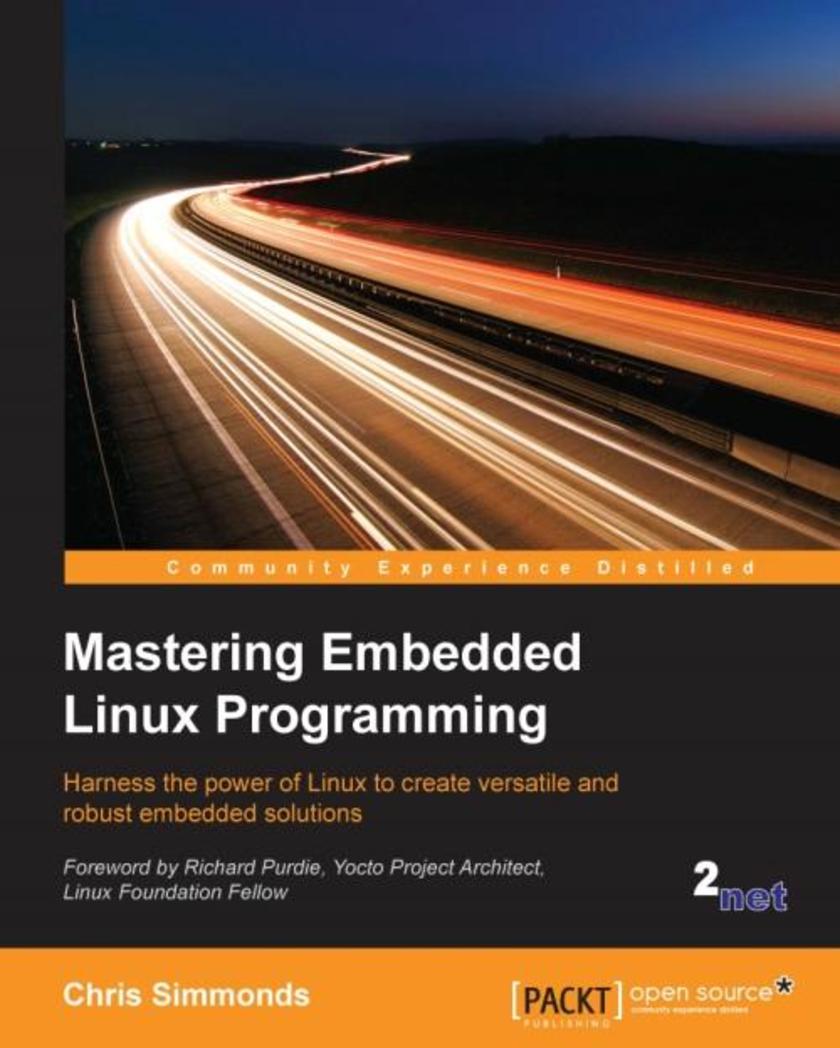
Mastering Embedded Linux Programming
¥90.46
Harness the power of Linux to create versatile and robust embedded solutions About This Book Create efficient and secure embedded devices using Linux Minimize project costs by using open source tools and programs Explore each component technology in depth, using sample implementations as a guide Who This Book Is For This book is ideal for Linux developers and system programmers who are already familiar with embedded systems and who want to know how to create best-in-class devices. A basic understanding of C programming and experience with systems programming is needed. What You Will Learn Understand the role of the Linux kernel and select an appropriate role for your application Use Buildroot and Yocto to create embedded Linux systems quickly and efficiently Create customized bootloaders using U-Boot Employ perf and ftrace to identify performance bottlenecks Understand device trees and make changes to accommodate new hardware on your device Write applications that interact with Linux device drivers Design and write multi-threaded applications using POSIX threads Measure real-time latencies and tune the Linux kernel to minimize them In Detail Mastering Embedded Linux Programming takes you through the product cycle and gives you an in-depth de*ion of the components and options that are available at each stage. You will begin by learning about toolchains, bootloaders, the Linux kernel, and how to configure a root filesystem to create a basic working device. You will then learn how to use the two most commonly used build systems, Buildroot and Yocto, to speed up and simplify the development process. Building on this solid base, the next section considers how to make best use of raw NAND/NOR flash memory and managed flash eMMC chips, including mechanisms for increasing the lifetime of the devices and to perform reliable in-field updates. Next, you need to consider what techniques are best suited to writing applications for your device. We will then see how functions are split between processes and the usage of POSIX threads, which have a big impact on the responsiveness and performance of the final device The closing sections look at the techniques available to developers for profiling and tracing applications and kernel code using perf and ftrace. Style and approach This book is an easy-to-follow and pragmatic guide consisting of an in-depth analysis of the implementation of embedded devices. Each topic has a logical approach to it; this coupled with hints and best practices helps you understand embedded Linux better.
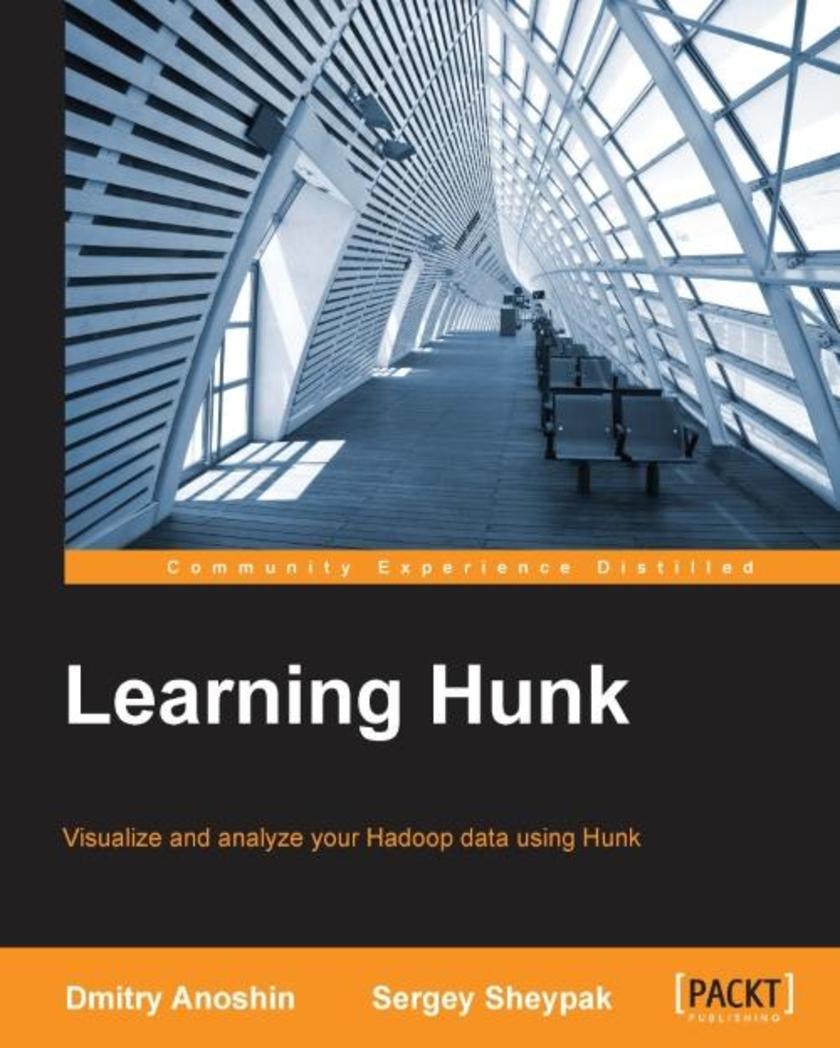
Learning Hunk
¥63.21
Visualize and analyze your Hadoop data using Hunk About This Book Explore your data in Hadoop and NoSQL data stores Create and optimize your reporting experience with advanced data visualizations and data analytics A comprehensive developer's guide that helps you create outstanding analytical solutions efficiently Who This Book Is For If you are Hadoop developers who want to build efficient real-time Operation Intelligence Solutions based on Hadoop deployments or various NoSQL data stores using Hunk, this book is for you. Some familiarity with Splunk is assumed. What You Will Learn Deploy and configure Hunk on top of Cloudera Hadoop Create and configure Virtual Indexes for datasets Make your data presentable using the wide variety of data visualization components and knowledge objects Design a data model using Hunk best practices Add more flexibility to your analytics solution via extended SDK and custom visualizations Discover data using MongoDB as a data source Integrate Hunk with AWS Elastic MapReduce to improve scalability In Detail Hunk is the big data analytics platform that lets you rapidly explore, analyse, and visualize data in Hadoop and NoSQL data stores. It provides a single, fluid user experience, designed to show you insights from your big data without the need for specialized skills, fixed schemas, or months of development. Hunk goes beyond typical data analysis methods and gives you the power to rapidly detect patterns and find anomalies across petabytes of raw data. This book focuses on exploring, analysing, and visualizing big data in Hadoop and NoSQL data stores with this powerful full-featured big data analytics platform. You will begin by learning the Hunk architecture and Hunk Virtual Index before moving on to how to easily analyze and visualize data using Splunk Search Language (SPL). Next you will meet Hunk Apps which can easy integrate with NoSQL data stores such as MongoDB or Sqqrl. You will also discover Hunk knowledge objects, build a semantic layer on top of Hadoop, and explore data using the friendly user-interface of Hunk Pivot. You will connect MongoDB and explore data in the data store. Finally, you will go through report acceleration techniques and analyze data in the AWS Cloud. Style and approach A step-by-step guide starting right from the basics and deep diving into the more advanced and technical aspects of Hunk.
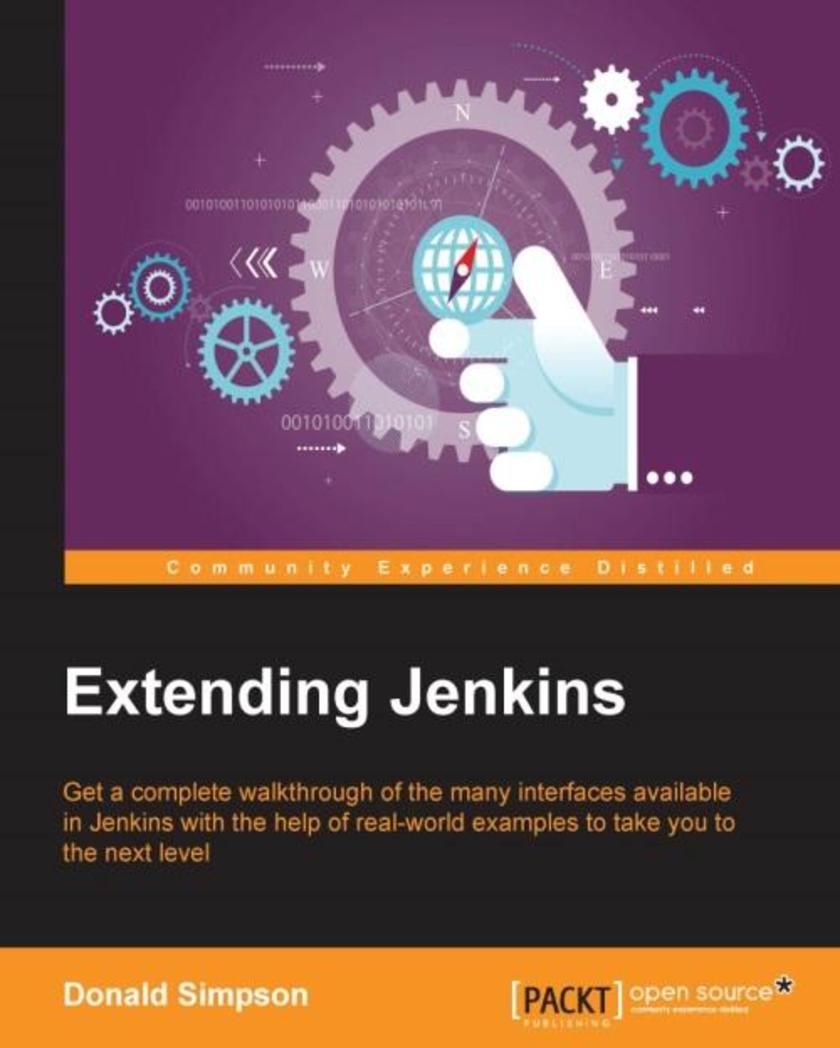
Extending Jenkins
¥63.21
Get a complete walkthrough of the many interfaces available in Jenkins with the help of real-world examples to take you to the next level with Jenkins About This Book Find out how to interact with Jenkins from within Eclipse, NetBeans, and IntelliJ IDEA Develop custom solutions that act upon Jenkins information in real time A step-by-step, practical guide to help you learn about extension points in existing plugins and how to build your own plugin Who This Book Is For This book is aimed primarily at developers and administrators who are interested in taking their interaction and usage of Jenkins to the next level. The book assumes you have a working knowledge of Jenkins and programming in general, and an interest in learning about the different approaches to customizing and extending Jenkins so it fits your requirements and your environment perfectly. What You Will Learn Retrieve and act upon Jenkins information in real time Find out how to interact with Jenkins through a variety of IDEs Develop your own Form and Input validation and customization Explore how Extension points work, and develop your own Jenkins plugin See how to use the Jenkins API and command-line interface Get to know how to remotely update your Jenkins configuration Design and develop your own Information Radiator Discover how Jenkins customization can help improve quality and reduce costs In Detail Jenkins CI is the leading open source continuous integration server. It is written in Java and has a wealth of plugins to support the building and testing of virtually any project. Jenkins supports multiple Software Configuration Management tools such as Git, Subversion, and Mercurial. This book explores and explains the many extension points and customizations that Jenkins offers its users, and teaches you how to develop your own Jenkins extensions and plugins. First, you will learn how to adapt Jenkins and leverage its abilities to empower DevOps, Continuous Integration, Continuous Deployment, and Agile projects. Next, you will find out how to reduce the cost of modern software development, increase the quality of deliveries, and thereby reduce the time to market. We will also teach you how to create your own custom plugins using Extension points. Finally, we will show you how to combine everything you learned over the course of the book into one real-world scenario. Style and approach Extending Jenkins explores and explains advanced Jenkins functionality from a practical point of view, teaching you real-world skills that will help you get more from this powerful software. Each key topic is explained clearly with a practical example, and in sufficient detail so you understand the concepts and can then develop your own solutions using your preferred software and languages.
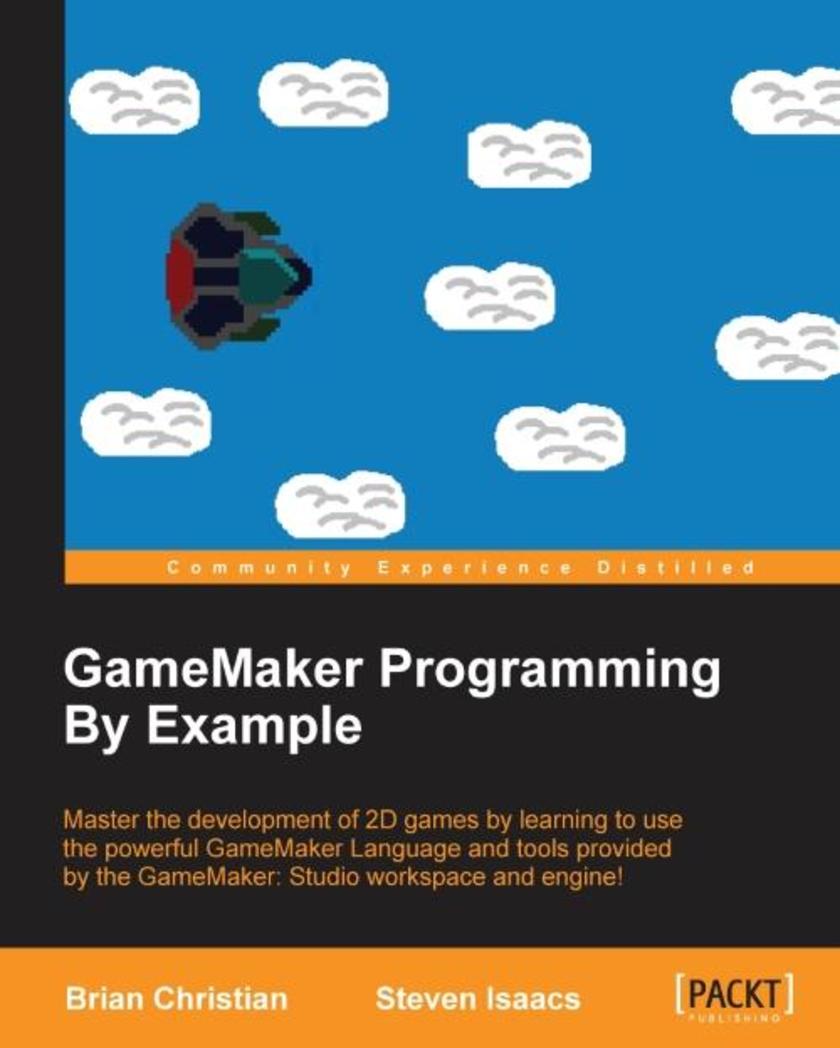
GameMaker Programming By Example
¥80.65
Master the development of 2D games by learning to use the powerful GameMaker Language and tools provided by the GameMaker: Studio workspace and engine! About This Book Rapidly develop games using the powerful yet easy easy-to to-use GameMaker: Studio engine Comprehensive: This is a comprehensive guide to help you learn and implement GameMaker’s features. Go through step-by-step tutorials to design and develop unique games Who This Book Is For If you have at least some basic programming experience of JavaScript or any other C-like languages, then this book will be great for you. No experience beyond that is assumed. If you have no game development experience and are looking for a hobby, are an experienced game developer looking to master some advanced features, or fit anywhere in that spectrum, then you will find GameMaker: Studio and this book to be very useful in helping you create exciting games. What You Will Learn Understand the GameMaker: Studio interface and tools to quickly create the various assets used in your games Translate some of the GameMaker: Studio drag and drop functions to the GameMaker language Create games with random elements for exciting gameplay Use the basic GameMaker file I/O and encryption systems Utilize the GameMaker networking functions to create multiplayer games Give AI routines to your enemies to make challenging gameplay Create particle systems to give your game exciting graphics Understand the various debugging techniques available in GameMaker: Studio In Detail This book is excellent resource for developers with any level of experience of GameMaker. At the start, we’ll provide an overview of the basic use of GameMaker: Studio, and show you how to set up a basic game where you handle input and collisions in a top-down perspective game. We continue on to showcase its more advanced features via six different example projects. The first example game demonstrates platforming with file I/O, followed by animation, views, and multiplayer networking. The next game illustrates AI and particle systems, while the final one will get you started with the built-in Box2D physics engine. By the end of this book, you have mastered lots of powerful techniques that can be utilized in various 2D games. Style and approach A This step-by-step guide that follows and with details ons different topics throughout the creation of various examples.
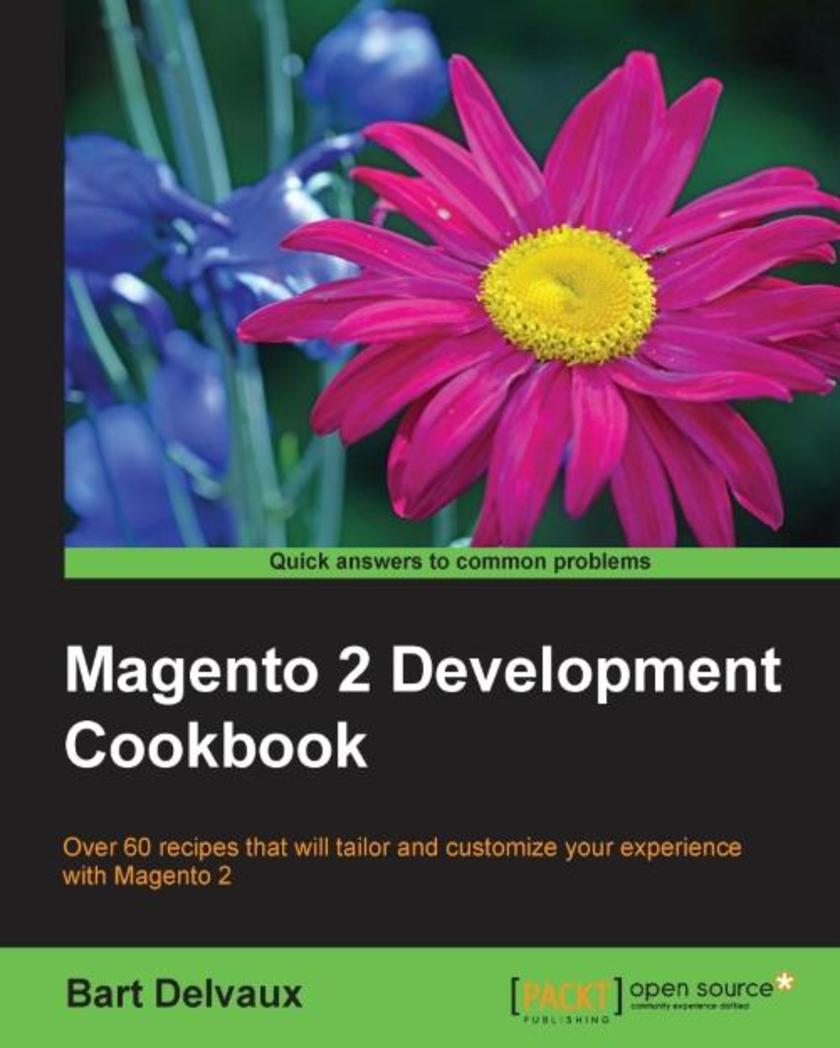
Magento 2 Development Cookbook
¥90.46
Over 60 recipes that will tailor and customize your experience with Magento 2 About This Book Solve common problems encountered while extending your Magento 2 store to fit your business needs Delve into the exciting and enhanced features of Magento 2 such as customizing security permissions, intelligent filtered search options, easy third-party integration, among others Learn to build and maintain a Magento 2 shop via a visual-based page editor and customize the look and feel using Magento 2’s offerings on the go Who This Book Is For This book is for every developer who has knowledge of PHP and wants to extend or customize the functionality of their Magento 2 system. If you have prior experience of the Magento platform, you will find this book useful in exploring the advanced features. What You Will Learn Install a Magento 2 shop with sample data Upgrade the data in a Magento 1 shop to a Magento 2 shop Manage the look and feel of the shop with custom themes Extend the shop with custom functionality such as forms, grids, and more Accelerate your store with some performance tool Build and structure your own shipping module Test your shop with automated tests and manage your product display In Detail With the challenges of growing an online business, Magento 2 is an open source e-commerce platform with innumerable functionalities that gives you the freedom to make on-the-fly decisions. It allows you to customize multiple levels of security permissions and enhance the look and feel of your website, and thus gives you a personalized experience in promoting your business. Style and approach This book is packed with a wide range of techniques to modify and extend the functionality of your online store. It contains easy-to-understand recipes starting with the basics and moving on to cover advanced topics. Many recipes work with code examples that can be downloaded from the book’s website.

Gradle Essentials
¥54.49
Master the fundamentals of Gradle using real-world projects with this quick and easy-to-read guide About This Book Write beautiful build *s for various types of projects effortlessly Become more productive by harnessing the power and elegance of the Gradle DSL Learn how to use Gradle quickly and effectively with this step-by-step guide Who This Book Is For This book is for Java and other JVM-based language developers who want to use Gradle or are already using Gradle on their projects. No prior knowledge of Gradle is required, but some familiarity with build-related terminologies and an understanding of the Java language would help. What You Will Learn Master the Gradle DSL by identifying the building blocks Learn just enough Groovy for Gradle Set up tests and reports for your projects to make them CI ready Create library, stand-alone, and web projects Craft multi-module projects quickly and efficiently Migrate existing projects to a modern Gradle build Extract common build logic into plugins Write builds for languages like Java, Groovy, and Scala In Detail Gradle is an advanced and modern build automation tool. It inherits the best elements of the past generation of build tools, but it also differs and innovates to bring terseness, elegance, simplicity, and the flexibility to build. Right from installing Gradle and writing your first build file to creating a fully-fledged multi-module project build, this book will guide you through its topics in a step-by-step fashion. You will get your hands dirty with a simple Java project built with Gradle and go on to build web applications that are run with Jetty or Tomcat. We take a unique approach towards explaining the DSL using the Gradle API, which makes the DSL more accessible and intuitive. All in all, this book is a concise guide to help you decipher the Gradle build files, covering the essential topics that are most useful in real-world projects. With every chapter, you will learn a new topic and be able to readily implement your build files. Style and approach This step-by-step guide focuses on being productive with every chapter. When required, topics are explained in-depth to give you a good foundation of the Gradle fundamentals. The book covers most aspects of builds required for conventional JVM-based projects, and when necessary, points you towards the right resources.
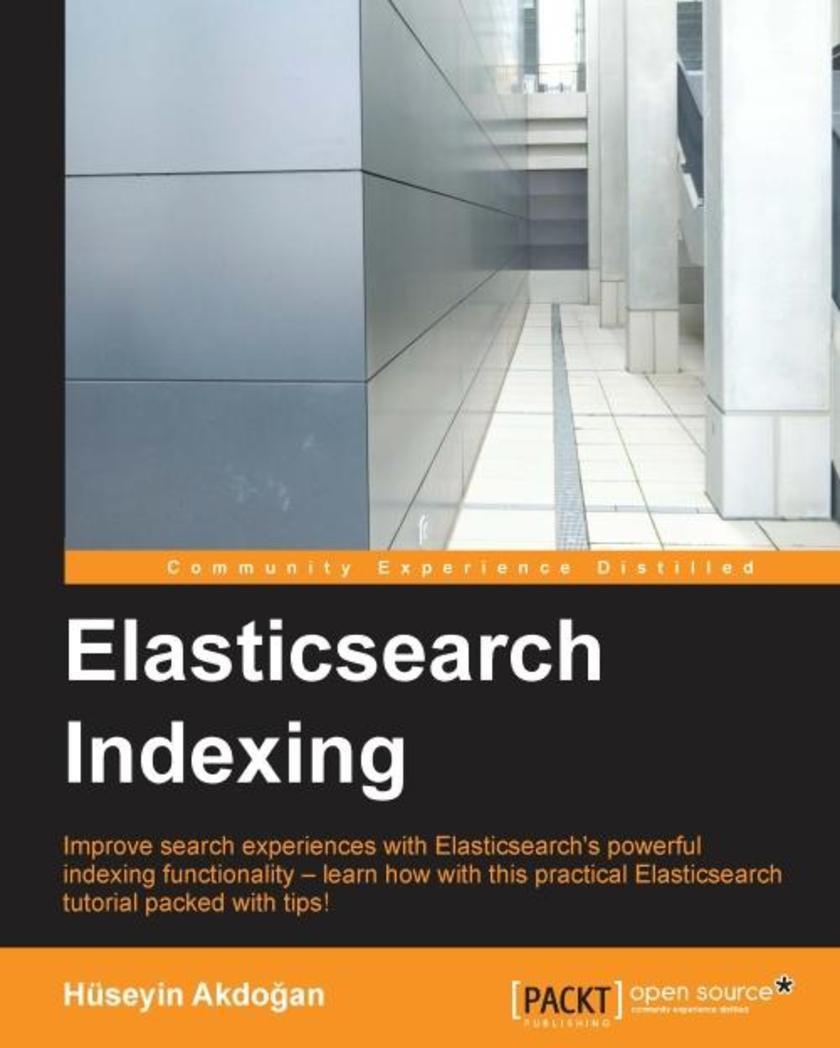
Elasticsearch Indexing
¥54.49
Improve search experiences with ElasticSearch’s powerful indexing functionality – learn how with this practical ElasticSearch tutorial, packed with tips! About This Book Improve user’s search experience with the correct configuration Deliver relevant search results – fast! Save time and system resources by creating stable clusters Who This Book Is For If you understand the importance of a great search experience this book will show you exactly how to build one with ElasticSearch, one of the world’s leading search servers. What You Will Learn Learn how ElasticSearch efficiently stores data – and find out how it can reduce costs Control document metadata with the correct mapping strategies and by configuring indices Use ElasticSearch analysis and analyzers to incorporate greater intelligence and organization across your documents and data Find out how an ElasticSearch cluster works – and learn the best way to configure it Perform high-speed indexing with low system resource cost Improve query relevance with appropriate mapping, suggest API, and other ElasticSearch functionalities In Detail Beginning with an overview of the way ElasticSearch stores data, you’ll begin to extend your knowledge to tackle indexing and mapping, and learn how to configure ElasticSearch to meet your users’ needs. You’ll then find out how to use analysis and analyzers for greater intelligence in how you organize and pull up search results – to guarantee that every search query is met with the relevant results! You’ll explore the anatomy of an ElasticSearch cluster, and learn how to set up configurations that give you optimum availability as well as scalability. Once you’ve learned how these elements work, you’ll find real-world solutions to help you improve indexing performance, as well as tips and guidance on safety so you can back up and restore data. Once you’ve learned each component outlined throughout, you will be confident that you can help to deliver an improved search experience – exactly what modern users demand and expect. Style and approach This is a comprehensive guide to performing efficient indexing and providing relevant search results using mapping, analyzers, and other ElasticSearch functionalities.
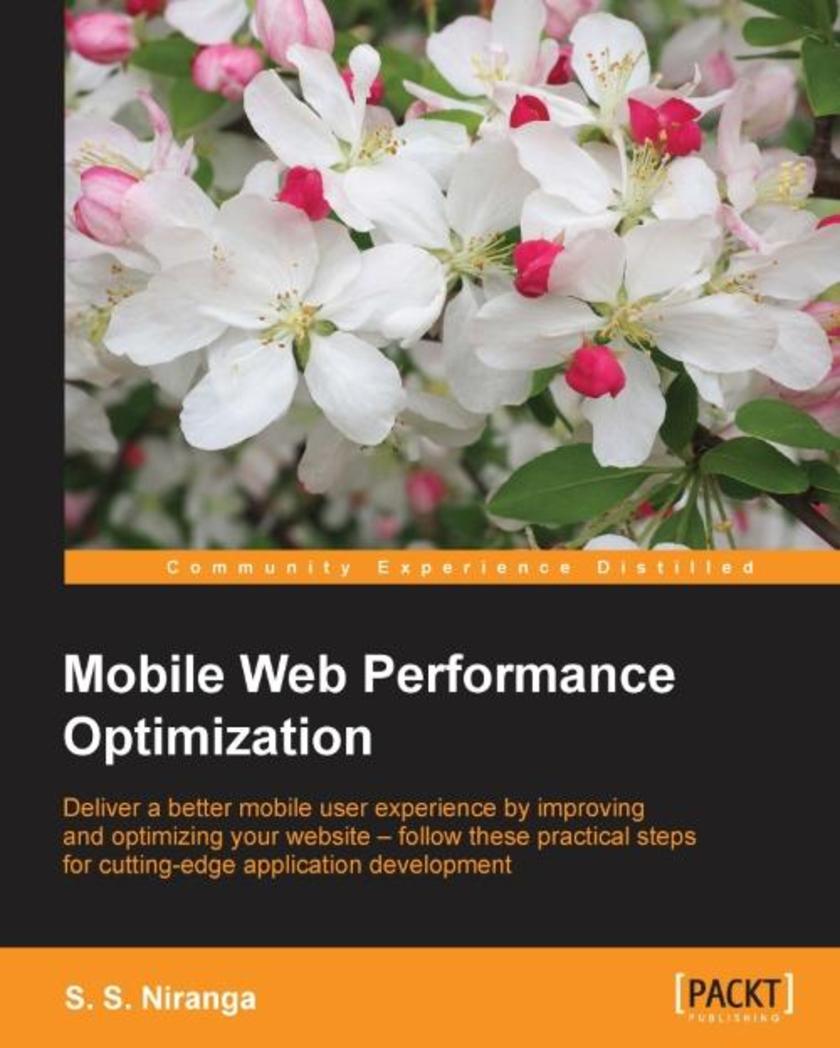
Mobile Web Performance Optimization
¥54.49
Deliver a better mobile user experience by improving and optimizing your website – follow these practical steps for cutting-edge application development About This Book Optimize your website or application for an improved mobile performance Learn how to create lightweight, intuitive mobile UI and make sure it's supported by a robust application architecture Find out how to improve the performance of your applications by asking the right design questions at each stage in the development workflow Who This Book Is For This book has been created for web developers who want to optimize their website for today’s mobile users. If you understand just how important user experience is, this book is for you – it will help you throughout the entire optimization process. What You Will Learn Learn the three pillars of mobile performance Find out how to ask – and answer – crucial design questions such as ‘mobile or responsive?’ Learn how to minify CSS and JavaScript for improved performance Monitor and debug your website with the leading browser testing tools Explore the impact of caching on performance – and improve it using JavaScript and CSS frameworks Make third-party plugins your friend – avoid common issues and pitfalls In Detail With users increasingly accessing the web on mobile devices, it’s crucial to make sure your website is built to seamlessly fit this radical change in user behavior. Mobile Web Performance Optimization is designed to help you do exactly that – it’s been created to help you build fast, and mobile-user-friendly websites and applications. Featuring guidance through a range of techniques and tools essential to modern mobile development, this accessible guide will make sure you’re delivering a seamless and intuitive experience for your website’s users. Begin by exploring the fundamental components of mobile web design and website optimization, before learning how to put the concepts into practice. Featuring cross-platform solutions, insights on developing lightweight yet robust UI, and insights on how to successfully manage data, this application development book takes you through every stage in the development process – so you can be confident that you’re asking the right questions and using the best tools in the most effective way. By the end, you’ll understand implicitly what it means to ‘build for performance’- you’ll be a more confident developer, capable of building projects that adapt to a changing world. Style and approach This book takes a step-by-step approach to mobile web optimization, explaining the topics in a conversational and easy-to-follow style. Each topic includes detailed explanations of the basic and advanced features of mobile web optimization.
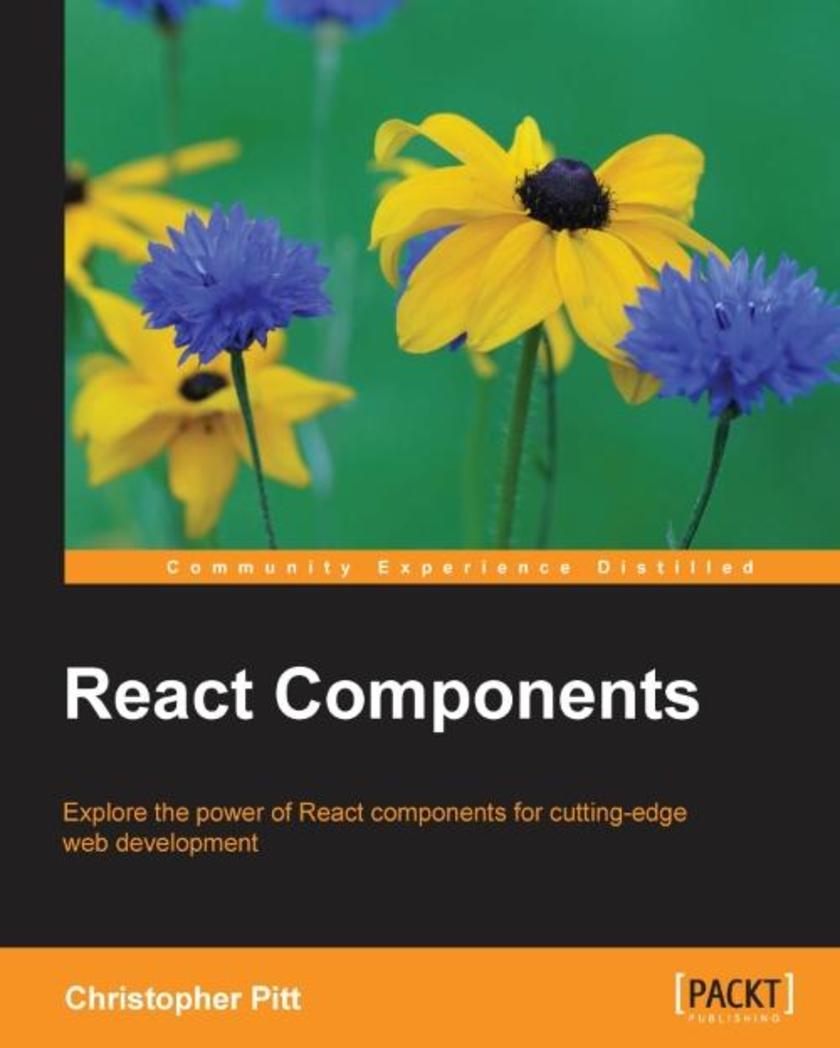
React Components
¥63.21
Explore the power of React components for cutting-edge web development About This Book Learn to build better websites by creating a variety of different components in React Conceptualize the design and build maintainable web apps with the help of components A fast-paced guide to help you learn about component-based development in React Who This Book Is For This book is ideal for developers who are familiar with the basics of React and are looking for a guide to building a wide range of components as well as develop component-driven UIs. What You Will Learn How to structure an app into components Working with nested components Work with nested components Set up communication across components Style the existing components Work with Material Design as a component Render components on the server Make the best of design patterns Make the app pluggable In Detail The reader will learn how to use React and its component-based architecture in order to develop modern user interfaces. A new holistic way of thinking about UI development will establish throughout this book and the reader will discover the power of React components with many examples. After reading the book and following the example application, the reader has built a small to a mid-size application with React using a component based UI architecture. The book will take the reader through a journey to discover the benefits of component-based user interfaces over the classical MVC architecture. Throughout the book, the reader will develop a wide range of components and then bring them together to build a component-based UI. By the end of this book, readers would have learned several techniques to build powerful components and how the component-based development is beneficial over regular web development. Style and approach This book is a compact, example-driven guide that provides a step-by-step approach.




 购物车
购物车 个人中心
个人中心



